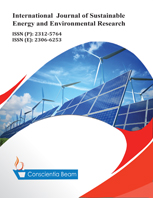Presenting an Energy-Efficient Model for the Envelope of High-Rise Office Buildings Case Study: Cold and Dry Climate
DOI:
https://doi.org/10.18488/journal.13.2021.102.85.100Abstract
The expansion of high-rise buildings and vertical cities has made room for a significant potential for large areas in the envelope (façade) of buildings to produce the required energy. This opens the opportunity to conduct research about the city of Mashhad-Iran. This study aims to provide an optimal model of the envelope of an office building and maximum utilization of sunlight in providing energy and indoor lighting in cold and dry climates. DesignBuilder software, version 6.1.0.006, to simulate the building and Energy plus 8.9 simulator engine was used to compare the amount of energy consumed, and electricity generated. We evaluated the data by the analytical-comparative method. The results showed that ,in one year, the energy produced by model number one (#1) (27.6%) and model number two (#2) (18.7%), among other simulated models with 15% efficiency (base efficiency rate) regarding all solar factors used in them, the amount of the electricity generated manifests a significant difference from the total electricity consumption of the building studied, assuming that the percentage of electricity supply with the actual efficiency of the proposed solar factors, are 17.99% and 17.88%, in model (#1) and model (#2). Once compared the given results of the models used for the photovoltaic panels, photovoltaic solar glasses, and the occupied area by them, a direct impact on the efficiency and energy generation of the building model envelope was seen. So, this study paves the road for further use of new technologies of building-integrated photovoltaic (BIPV) for locations that have similar climate.

